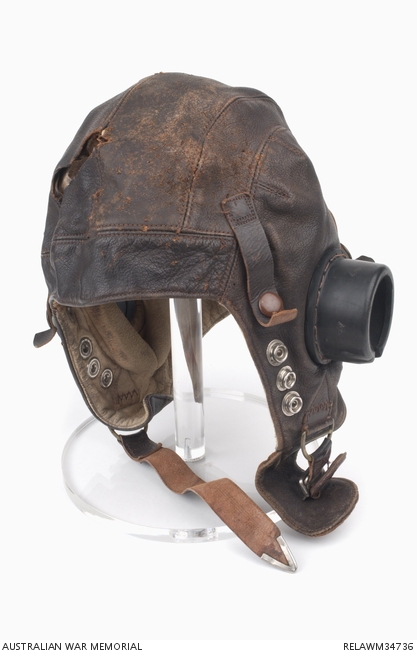| Places | |
|---|---|
| Accession Number | RELAWM34736 |
| Collection type | Heraldry |
| Object type | Helmet |
| Physical description | Brass, Chamois, Chrome-plated Metal, Leather, Rubber, Velveteen |
| Location | Main Bld: World War 2 Gallery: Gallery 2: Air Europe |
| Maker |
Air Ministry |
| Place made | United Kingdom |
| Date made | c 1941-1945 |
| Conflict |
Second World War, 1939-1945 |
British Type C flying helmet : Sergeant H J Erb, 460 Squadron RAAF

British issue brown leather Type 'C' unwired flying helmet. The helmet has a brown leather chin strap with a 'Bennett' friction fastener, and black rubber cups to protect external radio receivers (the receivers are not present). Below the rubber cups on each side of the helmet are three chromed metal snap fasteners to receive the Type 'E*' (E Star) oxygen mask. At the rear of the helmet is a single buckle strap and two brown leather snap fastening tabs to secure the flying goggle straps. Another pair of snap fastening tabs for the same purpose are located at the temples. Internally, the helmet is chamois lined and has chamois ear pads to reduce external noise. There is a brown velveteen sweat absorbing panel at the brow and inside the chinstrap. A slash in the leather on the right hand crown of the helmet was caused by a German flak splinter.
Henry Joseph Erb was born at Esk, Queensland, on 25 May 1922. He enlisted in the Royal Australian Air Force on 8 November 1941, receiving the service number 414665, and trained as an air gunner. He was posted to 460 Squadron, RAAF, as a mid-upper gunner in Avro Lancaster bombers. During an operation over Dortmund on May 23, 1943, Sergeant Erb's flying helmet was struck by a splinter from a German flak burst near his turret. He suffered shrapnel wounds to his forehead and other scars were caused to the helmet by Perspex splinters. Later awarded the Distinguished Flying Cross after completing a second tour of operations with 467 Squadron, RAAF, he finished the war with the rank of flying officer, and was discharged from the air force in October 1945.